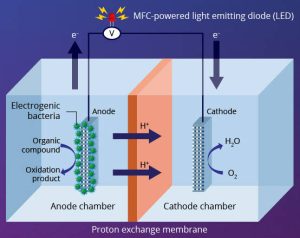
As well as the sensed contaminant, the organic mater is also the power source of this detector, which is essentially a novel floating fuel cell, with an LED on top.
“The microbial fuel cell case was fabricated by a 3D printer and the electrodes were fabricated from low-cost carbon-based materials,” said Ritsumeikan’s Professor Kozo Taguchi, who led the study.
Electrogenic bacteria – microorganisms which produce an electric current as a result of their biological metabolism – are the key to this kind of fuel cell.
“The amount of electricity generated by the fuel cell is proportional to the concentration of the organic waste that is being consumed by the electrogenic microorganisms,” according to the university. “This characteristic feature is, thus, used to design organic waste biosensors powered by microbial fuel cells.”

The Ritsumeikan cell measures 70 x 85 x 9mm tall.
Its cathode is a mixture of activated carbon, carbon fibre, copper powder, Nafion and multi-walled carbon nanotubes, with a current-collecting stainless steel mesh, while the anode is carbon fibre and multi-walled carbon nanotubes.
Soil containing electrogenic bacteria was added to the anode chamber, where they could usefully emit electrons when surrounding water contained organic matter that they could decompose.
“Although the researchers did not characterise the bacteria in the soil sample, they hypothesised that microorganisms from the genera Geobacter, Shewanella, and Pseudomonas contributed to the electrical activity,” said the university, explaining that prior studies have show that paddy soils naturally contain electrogenic bacteria from these genera.
Via a ‘MudWatt’ educational boost converter, an LED was connected across the cell, and this began to flash when the ‘chemical oxygen demand’ (COD, the metric used as an organic pollution marker in this research) exceeded 60mg/litre, with flashing rate increasing non-linearly beyond this.
Several cells were made, and they remained working after five months.
The work has been published as ‘Stand-alone floating microbial fuel cell-based biosensor for tracking organic pollution influx‘ in the Biochemical Engineering Journal.
Image Credit: Kozo Taguchi, Ritsumeikan University
 Electronics Weekly Electronics Design & Components Tech News
Electronics Weekly Electronics Design & Components Tech News



